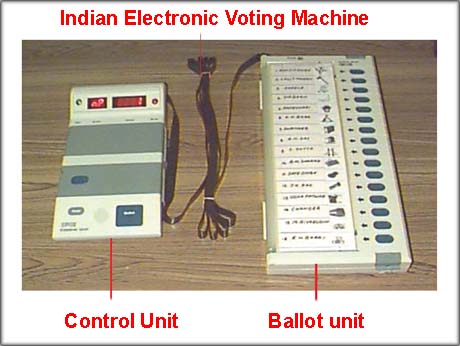
A sense of deja vu about '82It is a sad day, when an Indian professional who chose to question whether a key instrument and an enabler of elections in the world’s largest democracy , might not be fool proof -- is arrested on a charge of having “stolen” that very instrument for his study. and has to spend over a week in custody before being granted bail ( on Aug 28). Hari K. Prasad did whatever he did, openly -- he joined with some international scientists in the Netherlands and the US, in a study to see whether the Electronic Voting Machine (EVM) that India has been using in all central and state elections for nearly a decade, is tamper-proof, as claimed. ( our earlier story: http://www.indiatechonline.com/indian-evm-and-security-concern-307.php ).
We do not know how he obtained an EVM for his study; in all probability one among the thousands, responsible for the safe custody of over 1.3 million of these machines, between elections, ‘ lent’ him a unit for a brief period. None of the government agencies involved --The Election Commission of India and the two government undertakings that manufacture the EVMs, BEL Bangalore and ECIL Hyderabad -- has been very helpful to public spirited citizens, who presumed to question if the Indian EVM could be “fixed” to skew the result. Official pronouncements have been arrogant and dismissive on the lines of: “The EVMs are tamper proof , because we say so”. That is a most dangerous position to take in anything that touches Information Technology today. IT evolves so swiftly, that the “latest” PC or a mobile phone, that you and I buy, is probably obsolete even as we bring it home, because the makers are already working on the next model, and addressing bugs and glitches that they knew were present in the model they sold you. Canadian media guru said it decades ago: “If it works, it’s obsolete”.
An EVM is an electronic gadget. Can it remain immune to the ‘ garam hava’, the hot wave of change that impacts every single electronic product? Indian EVMs have been use for 12 years now. Assuming for a moment ,that the technology it deployed, was cutting -edge when it was first designed, is it likely to remain so after 3, 5 or 7 years? Are they updating the technology? How often? When was this last done? If no one tells us, what are we, citizens who are going to be using them to elect and discard public servants, expected to assume? The best -- or the worst?
Ethical hacking, anyone? The bureaucrats who issue the periodic certificates of good conduct to the EVM, may not have come across a new buzzword: ethical hacking. Hacking used to be a crime – breaking illegally into someone else’s computer or network. But the guys who are best at this, are not all criminals. Many banks and large corporations, hire ethical hackers , to try and break into their critical networks. If the hackers succeed, the corporations plug the holes. This is a continuing process. What did Hari Prasad and his international team do, that is any different? Maybe there is one difference: They did it for free, when the EC should have actually said: 'Here is an EVM: We hereby hire you to try and crack it. If you can make it distort the result, tell us how, so that we can change our system to make sure it does not happen in a real election'. That is the way governments deploying technology that touches millions of their citizens, should react – not shoot the messenger who says,’your EVM sucks’.
Flashback to 1982
I feel a certain nostalgic tug while writing all this. An EVM was used in India for the first time in 1982, in a by-election in the North Paravur constituency in the state of Kerala. The candidate who lost that election – A.C. Jose of the Congress Party – moved the Kerala High Court against the result, citing vulnerability to tampering in the machines used. I was a young engineer, heading the electronics division in a defence R&D lab in Kochi at the time – and was served with a court order to evaluate the technical merits of Jose’s claim. For a few weeks, I grappled with the technology of ROMs or read only memory chips, which, in the early versions, were used to store the machine coding of the EVM. I never got my day in court… even without any revelations from me, the court set aside the election, on the grounds that electronic voting was not envisaged in the People’s Representation Act. That remained the position till the Act was amended by Parliament and EVMs legalised for the first time in the state elections of 1998 in Madhya Pradesh, Rajasthan and Delhi .
The general elections of 2004 were India’s first all-electronic polls -- and since then, the Indian EVM has generally measured up to its task; indeed, the machines are being exported to a few nations. We have moved away, from the old paper ballot days – and there is perhaps, no going back, even if some political parties might so wish. The size of our elections, makes that option untenable. That is not to say, that our EVMs are perfect. They will have to evolve, like all digital devices, with the shifting goal posts of technology. It is even possible, as many experts suggest, that electronic voting to be fool proof, should be generate some sort of paper audit trail. The challenge is to evolve India’s EVM technology, ego-lessly and professionally, building on the knowledge of our technologists – and on the zeal civil society’s watchdogs and whistle blowers .
Not by a few government agencies, arrogating all knowledge and wisdom to themselves, while unwilling to concede that men like machines, are fallible.
Anand Parthasarathy